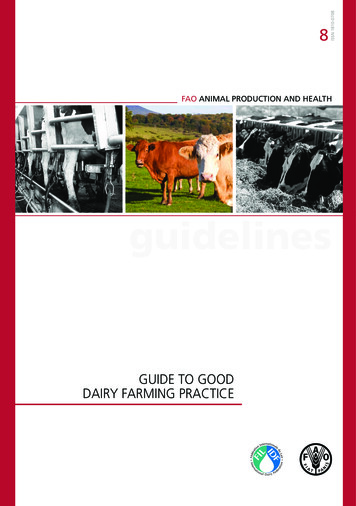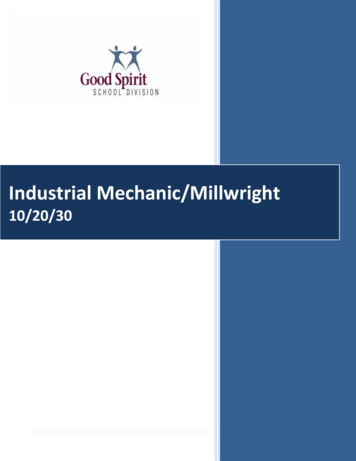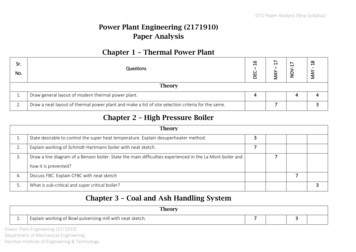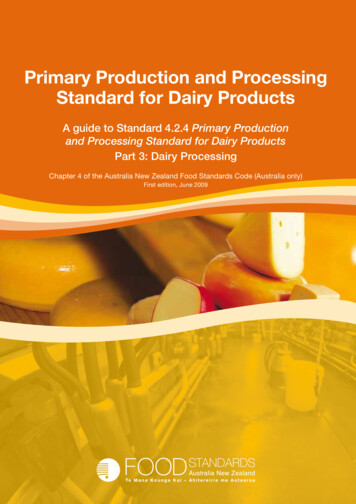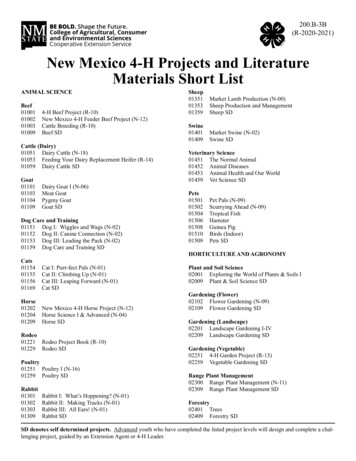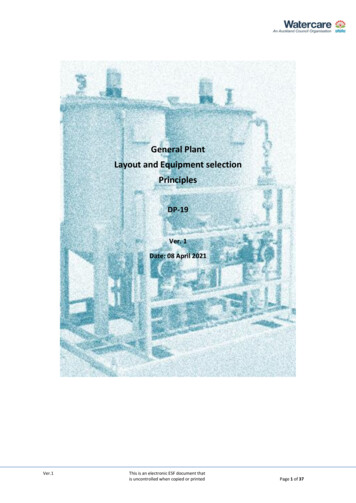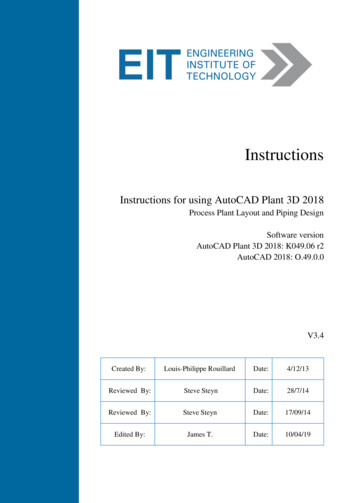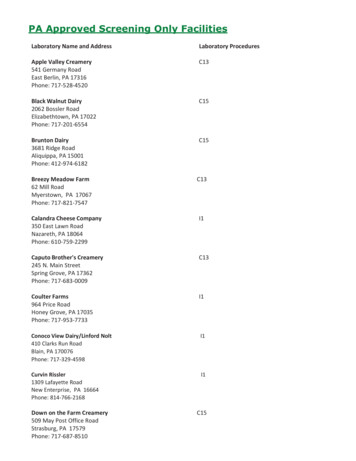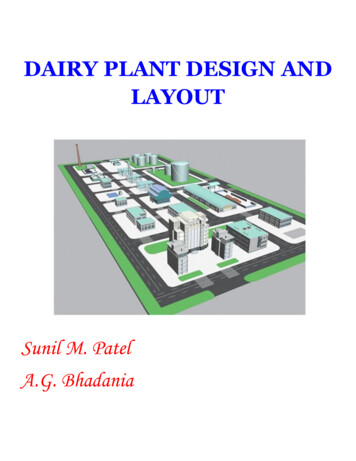
Transcription
DAIRY PLANT DESIGN ANDLAYOUTSunil M. PatelA.G. Bhadania
Dairy Plant Design & LayoutCourse DevelopersSunil M. Patel & A.G. BhadaniaDepartment of Dairy EngineeringAAU, AnandEditorDairy Plant Design and Layoutwww.AgriMoon.Com2
Course Outline 3 (2 0 2)Module 1. Introduction of Dairy Plant Design and LayoutLesson 1.Types of Dairies and Perishable nature of milkLesson 2.Importance of Dairy Plant DesignLesson 3.Milk ProcurementLesson 4.Milk ReceptionLesson 5.Classification of Dairy PlantsModule 2. Location and Site Selection for Dairy PlantsLesson6. Location of Dairy Plant and Types of LocationsLesson 7.Location of Fluid Milk Plant and Milk Product PlantLesson 8.Site SelectionLesson 9. Location of Milk Product PlantModule 3. Planning and principles of dairy plant layoutLesson 10.Importance of planning and principles of dairy plant designLesson 11. Dairy building planningLesson 12.Preparation of process scheduleLesson 13.Space requirement for dairy plantLesson 14.Estimation of service requirements including peak load considerationModule 4. Design aspects of dairy plantLesson 15.General points of consideration for designing dairy plantLesson 16.Different types of layoutsLesson 17. Single or multilevel designLesson 18.Service accommodationLesson 19. Arrangement of different sectionsLesson 20. Service pipe- line layoutLesson 21.Equipment layoutDairy Plant Design and Layoutwww.AgriMoon.Com3
Lesson 22.Layout of offices and workshopsLesson 23. Material handlingLesson 24.Preparation of detail layout with model planningLesson 25.Common ProblemsModule 5. Building construction materials and type of building constructionLesson 26.Choice of building construction materials - Brick, sand, cement, lime etc.Lesson 27.Building materials – stones, wood, metal, glass etc.Lesson 28. General requirement of dairy floors and floors for different sectionsLesson29.Structural Aspects of Foundations, Roofs, Ceilings, Walls, Doors and windowsLesson 30.Drain and drain layout for small and large dairiesLesson 31.Ventilation, Illumination and fly controlLesson 32.Paints, coatings and mold preventionDairy Plant Design and Layoutwww.AgriMoon.Com4
Module 1. Introduction of Dairy Plant Design and Layou tLesson 1.Types of Dairies and Peris hable nature of milk1.1 IntroductionSince India is the leading country in milk production in the world at a fast rate, it has been lead to a need of veryscientific layout and planning for the dairies being set up by the dairy designers, engineers and architects. Insome organized sectors, milk collection and chilling of milk is done, before it is transported for processing atdairy factory. The dairy technology commences with processing of milk at dairy plant for market milk andvarious dairy products. The dairy plant layout and design means designing a layout plan for dairy plant. i.elayout of various sections in dairy building, equipment layout, laying of dairy machines in each section foreconomical and efficient movement of men and material in the plant.Milk and milk products, however, impose certain requirements which do not occur elsewhere in food or otherindustries. These special requirements affect the structure and the layout of the building, the provision anddistribution of services and the choice of site. The products of dairy industry – milk for liquid consumption,yoghurt, curd, cream, butter, ghee and similar products, cheese, milk powder and so on- are foods which play afundamental part in human nutrition. Materials and methods used in building must be such as to give the longestpractical life with the minimum of maintenance, in spite of working conditions which are often relatively severefrom both the mechanical and chemical point of view. It should also be seen that most of the repairs, alterationsor extensions could be done without stopping the production. These characteristics demand closest attentionduring planning.There is a need for highest standard of hygiene. Milk is most suitable medium for the growth of microorganism,therefore every possible measure should be taken to reduce the possibility of contamination, especially afterprocessing. A good layout design and use of proper materials and techniques make great contribution towardshygiene. The dairy layout needs careful thought and planning keeping in view manufacture of the products andtheir commercial aspects.1.3 Peris hable nature of milkMilk by its nature is perishable. The following three factors contribute to its being perishable:(i) Contamination with bacteria due to widely dispersed and unhygienic collection methods(ii) Warm temperatures of tropical climate(iii) Prolonged time before cooling or processingIn practice, none of these factors can be eliminated completely, so if any one is accentuated, the life of milk willdecrease. Therefore, every effort must be made to minimise these factors on the farm, during collection at milkplant and during distribution to consumers. At the farm, the aim must be to cool milk as soon as possible aftermilking. Ideally, the milk should be chilled to 4 C within two hours after milking. If for any reason this can notbe done at farm, quick transport of milk to the plant is essential. If milk can be stored conveniently at the farmor local collecting depot at low temperature, the organization of transport to milk processing plant is simplifiedto greater extent by transporting bulk quantity in insulated tankers. The type, size and number of vehiclesDairy Plant Design and Layoutwww.AgriMoon.Com5
necessary are, therefore determined not only by the usual factors such as distance or nature of roads but also bythe condition of milk production.When the milk is drawn from the udder of the milch animals (cows, buffaloes, goat, sheep, etc.), the quality ofmilk is almost sterile. The milk has its own anti- microbial system present which is active till 2 to 3 hours ofmilking. The components in milk such as lacto-peroxidase system, immunoglobulins, lactoferrin, etc. have theanti- microbial effect. The perishable nature of milk comes into picture with the contamination from air, huma n,and milking utensils. The temperature of milk during milking is equal to body temperature i.e., 37 C. The milkbeing very rich in nutrients such as carbohydrates, fats, proteins, minerals, vitamins and water, becomes goodmedia for the growth of micro-organisms. So the milk should be immediately sent to the dairies within 2 or 3hours of milking, before it gets sour. If the dairy is very far away from the milk collection area, it should bechilled to below 10 C in the bulk milk coolers at the farm level (village co-operatives and/or chilling centres) sothat the microbial activity is inactivated.1.2 Types of Dairies:******Dairy Plant Design and Layout ******www.AgriMoon.Com6
Lesson 2.Importance of Dairy Plant Design2.1 Introduction:Dairy Plant design, involves the estimation of capacity, process scheduling and proper layout so as to achievethe objective of handling milk at the least cost and greatest safety. However, the dairy industry and the plantdesign has to meet certain special requirements and need to be focused on these. The following are the fewaspects that make the dairy industry as a unique one.Special Characteristics of Dairy Industry:1. Perishable nature of milk: Milk is one of the most perishable of the agricultural commodities, and hasonly few hours of shelf life unless it is chilled and processed. Hence, the TIME factor is the mostimportant aspect to be involved in the dairy plant design and la y out2. Milk is an essential commodity. It provides nutrition especially to children and aged. Hence the dairyindustry has a high profile in the society, and its functioning is very essential to the well being of thesociety.3. Seasonal nature: The dairy industry has to deal with availability of raw milk fluctuations depending onthe season. It is available in certain months, called Flush season when most of the calving and greenfodder is available. During summer months, when milk availability dips due to most of the animalscoming to end of their lactation period. Hence, OVER CAPACITY is the factor to be considered in plantdesign and layout, as the plant is to meet the peak procurement of the flush season, while in theremaining months it is having excess capacity. Also flexibility of the plant design and layout has to beconsidered.4. Milk is a food item, which has to be consumed, especially by children and old people. Hence, PLANTHYGIENE is the important factor in plant layout and design.5. Effluent disposal of dairy plant is essential as the volume and BOD value of the dairy effluent is high.Sufficient planning is required to handle this high volume of effluent to be handled by EffluentTreatment Plant (ETP).6. Dairy Industry has to meet the various legal aspec ts and mandatory requirements. It has to meet theIndustrial act, Labor act, Boiler act, Pollution control act. It also has to meet the HACCP and FSSAIguidelines.2.2 Importance and economics of plant design:The products of dairy industry i.e., liquid milk, yoghurt, curds/dahi, cream, butter, ghee, ice-creams, cheese,milk powders, shrikhand, traditional Indian dairy products etc. are foods which are very important for humannutrition. Therefore, it is very necessary that the milk and milk products should be available to everyone at thelowest possible rate. Also the profit margin that the dairy entrepreneur expects is limited. Therefore, the capitaloutlay of the building and plant should be economical. Planning must be done wisely to make best use of thelabor employed and to keep operating costs to a minimum. Materials and method used in building must be suchas to give the longest practical life with the minimum maintenance, in spite of working conditions which areoften relatively severe from both mechanical and chemical points of view. It should also be without stopping theproduction.Dairy Plant Design and Layoutwww.AgriMoon.Com7
To extend the shelf- life some techniques like quick heating, quick cooling, acidification etc. are applied andalso various advanced packaging techniques are used. The Dairy Technology starts with milk processing till thefinal products such as market milk and conversion into various products. So the subject Dairy Plant Design andLayout is the designing of layout plan for a dairy plant, i.e., layout for different sections in the dairy building,equipment layout, laying of dairy machines in such a manner that it allows efficient and economical movementof men and material in the plant in each section. The subject contains several applications of fundamentaltopics, such as locations site selection, building materials, specific requirements of each section includingservice sections.2.3 Legal and comme rcial aspects of plant design:Care should be taken to provide adequate natural and artificial lighting. Every possible effort should be made toensure that the building and the site will be pleasant to look at. The architect can provide a good landscape andan attractive outlook. The welfare of the employees must be kept in view. Canteen facilities are essential tomeet the requirement of Labor act. Ultimately, the dairy plant layout requires careful thought and planningkeeping in view manufacture of the products and their commercial aspects. A sound layout engineering containsallowance for increase in capacity by arranging the production departments and selecting the type of buildingthat can be expanded at low cost. It should be easy to increase the output capacity which may be required in thefuture. A floor arrangement that contributes to the low cost production planning a nd control are achieved ingood plant layout. Material control and steady amount of production capacity can be easily attained withminimum idleness of machinery and man. Finally leading to the delivery of products in short notices can beachieved.Safety and good working conditions are very necessary in a proper plant layout. Minimized hazards at theworking stations, in material handling, storage, maintenance operations and so on are features of good plantlayout. Minimum man hour losses, reduction in cap ital equipment and material losses incorporate improvedworking conditions. Increased employee moral tends to reduce production costs and helps develop a stableoperating force.In planning the building, several important factors have to be studied in deta il before the plant could bedeveloped to the stage of construction. The size of the building and the floor space to be provided depend uponthe processes and choice of appropriate steps, numbers and associated equipment to be accommodated and themost important factor of rearrangement of facilities in the initially built building and provision for expansion ofthe building without costly modifications. A high degree of sanitation is necessary to ensure protection fromcontamination, odours, chemicals, organisms, etc. This includes the interior and exterior of the building andsanitary conditions of the environment. Simple pleasing design with high utility value without undueimportance to architectural factors is necessary.Civil Engineering aspects of plant design : The type and methods of use of civil construction is evolving day byday. New materials are being developed to meet specific requirements of industries. The planning of civilconstruction is very much related now to meet the requirements of HACCP and FSSAI acts, which are morestringent in nature. Structural modules of RCC Columns and beams gives good flexibility in the location of theequipment and layout of service lines. The height of the ceiling is another important factor. Plain smoothsurface of the underside of the ceiling with embedded fixtures for lighting and pipe supports, etc. , into theceiling is best.Dairy Plant Design and Layoutwww.AgriMoon.Com8
2.4 Advantages of a good plant layout1. A good layout reducesa. the effort in normal material handling of a workerb. cost of handling by direct labor and hence increased productivity per man hour andc. indirect manufacturing cost by decreasing spoilage under difficult handling situation2. It uses only essential space required and eliminate congestion and accident, permits flexib ility for methodsimprovement and future expansion besides making supervision easier.3. It also facilitates scheduling and despatching operation.******Dairy Plant Design and Layout ******www.AgriMoon.Com9
Lesson 3.Milk Procurement3.1 Introduction:The wide range of milk procurement methods and handling has an affect on the plant design and layout. Themethod of milk procurement is also changing over the years. The recent trend of Bulk Milk Cooling at villageclusters is altogether eliminating the procurement of milk by cans at the Dairy plants.Lack of attention during procurement, processing and storage leads to decrease in the milk shelf- life. Quickchilling of milk should be done during the procurement if the dairy is far away from the Dairy Processing Plantand such milk is to be transported in bulk in insulated tankers to the dairies. In India, milk production is carriedout in rural areas from where it is transported to milk processing plant. Thereafter distribution to consumers isdone through depots and/or milk parlours.3.2 Milk procurement:In most of the countries, milk production is carried out in rural areas from where it is transported to milkprocessing plant. Under Indian conditions, milk has to be regularly collected and transported twice a day,morning and evening. The usual methods of milk collection and reception at dairy plant are:(i) Milk procurement through individual producers: In this milk is brought to the dairy plant by the individualproducers in their own vessels of any type. This is possible for those producers who are located nearby milkcollection centre.(ii) Milk collected through co-operative organizations: Here, co-operative societies form an organization whichis responsible for uninterrupted supply of milk to the dairy plant. Supply of milk can also be affected by singleco-operative society formed by milk producers. This is beneficial to the producers as there is no middle man toshare profit.(iii) Milk procured through contractors: In this method the contrac tor supplying milk to the dairy plant collectsthe milk from producers at a cheaper rate and transports the milk to the dairy. Therefore, there is less return tothe milk producers, as milk contractor will keep his share in the profit.(iv) Milk reception from milk collection cum chilling centres: This method is generally possible and is prevalentin organized sectors, and dairy operations in India.Milk is collected at various milk collection centres from nearby villages in 40 litre cans usually belonging to theorganization. The milk is weighed, tested for fat content and kept ready to be dispatched to the milk chillingcentre. From collection centre milk is picked up in an open truck and brought to milk chilling centre or dairyplant, where milk cans are emptied, washed through can washer and sent back to milk collection centres fornext day collection of milk.Dairy Plant Design and Layoutwww.AgriMoon.Com10
3.3 Three tier structure of ‘Anand Patte rn’The Anand pattern for collection of milk, processing and marketing of milk and milk product is very popular forco-operative structure in Gujarat, and few other states. Fig. 3.1 shows three tier system of „Anand Pattern‟.i) The Village SocietyAn Anand Pattern village dairy cooperative society (DCS) is formed by milk producers. Any milk producer canbecome a DCS member by buying a share and committing to sell milk only to the society. Each DCS has a milkcollection centre where members supply milk every day. Each member's milk is tested for quality withpayments based on the percentage of fat and SNF. At the end of each year, a portion of the DCS profits is usedto pay each member a patronage bonus based on the quantity of milk poured.ii) The District UnionA District Cooperative Milk Producers' Union is owned by dairy cooperative societies. The Union buys all thesocieties' milk, then processes and markets fluid milk and products. Most Unions also provide a range of inputsand services to DCSs and their members: feed, veterinary care, artificial insemination to sustain the growth ofmilk production and the cooperatives' business. Union staff train and provide consulting services to supportDCS leaders and staff.iii) The State FederationThe cooperative milk producers' unions in a state form a State Federation which is responsible for marketing thefluid milk and products of member unions. Some federations also manufacture feed and support other unionactivities.The transportation of milk to milk collection centre by various methods has an important bearing on the qualityand time constraints placed on the milk procurement.Dairy Plant Design and Layoutwww.AgriMoon.Com11
******Dairy Plant Design and Layout ******www.AgriMoon.Com12
Lesson 4.Milk Reception4.1 Introduction:The objective of handling the milk as quickly as possible continues even at the milk reception, as the milk isstill vulnerable to the spoilage, till it is chilled and taken into milk storage tank, and processed. The crucial stageof milk reception also involves the responsibility of checking the quantity, quality for acceptance, and the timemanagement of handling many vehicles.As mentioned earlier the timing is an important parameter while decid ing about the mode of reception andtransport. The load, distance to be covered and relative merits are given below in Table 4.1 and 4.2.Dairy Plant Design and Layoutwww.AgriMoon.Com13
4.2 Reception at the Dock:The milk as soon as it is received at plant, is weighed, dumped into the dump tank (we igh tank) and has to bechilled before it is stored for processing. This has to be done in quick succession through equipment wellplanned and installed at milk reception dock and receiving room.The reception of milk at the Raw Milk Reception Dock (RMRD) is done in three ways i.e., in cans, in milktankers and combination of both. The type, size and number of vehicles can be determined by factors such asdistance or nature of the roads and condition of milk production. In the chilling centres or BMCs, the milk isreceived only in cans (may be 40 lit or 20 lit capacity cans). In case of Marketing Dairies, the milk is receivedonly in milk tankers where as in feeder dairies the milk is received in both cans as well as in tankers. The trendof establishing BMCs at village clusters has changed the mode of reception and monitoring of quality andquantity at Dairies.There are some products that depend on the type of milk like cow and buffalo milk. Therefore, the receptiondock may consists of two separate systems for cow milk reception and buffalo milk reception at chilling centresas well as in feeder dairy plants. In most of the dairy plants however, the milk is received as mixed milk.If the milk is received in bulk through tankers, the arrangement has to be made for quick transfer of milkthrough milk pumps installed at milk reception dock to milk storage tanks. The milk received in the eveningmay be chilled and the stored for processing next day. All this will need careful planning of layout of equipmentat milk reception dock and milk receiving room. Roads leading to milk reception dock and dispatch dock haveto be planned in such a manner so as to avoid traffic congestion inside the factory or road blockage.4.2.1 Essential features of RMRD :The RMRD dock should be of height suitable (usually 1.5 m) to receive milk from whatever mode of transportwithout spillage during unloading. For Milk tankers, the Tanker Bay must be spacious, suitable for washing andunloading at least two tankers at a time. The pump should be of 20,000 l/h capacity to unload faster. If the milkquantity is to be measured by weigh bridge, it should be properly calibrated and inspected periodically by localweights and measure authorities. If the quantity is to be measured by dip stick alone, then the tanker by must besuitably leveled to avoid errors in measurement.4.3 The important equipme nts for reception of milk processing plant on the RMRD are:· Can conveyor: It should be of suitable type and length to transport easily the cans from the edge of the dock tothe can tilting bar at the dump tank. The rate of reception and capacity of the dairy plant are also important indeciding about the type of can conveyor, like whether a Roller type or motorized chain conveyor.· Milk weighing tank: The equipment involves a weigh bowl and dump tank. The capacity of weigh bowlshould be able to weigh at least 4 cans, which may be an average quantity received from each village. Weighbowl may be linked to indicate on a dial type of scale or through load cells in digital form of indication andrecording· Weighing scale: The weigh scale must at least be of 300 kg, so that the normal range of quantity of milkreceived from village is between 40 to 60% of the scale. The trend of digital indication through load cells arecatching up, which has the advantage of recording as well as print out simultaneously, for easy monitoring anddocumentation. This is improving the confidence level between milk collection centres and dairy that isreceiving the milk.· Dump tank with cover: The capacity of Dump tank is at least twice the capacity of weigh bowl, so that whilethe milk quantity of one village is being weighed, the other quantity is being pumped out from dump tank to theDairy Plant Design and Layoutwww.AgriMoon.Com14
milk chiller. Recent trend is to link the level sensors and milk pump to get started and stopped when the milklevel is high and low respectively.· Drip saver: The drip saver must be of SS and should have drain leading to the dump tank, or to a separate can,which is emptied to dump tank from time to time.· Can washer: The capacity of can washer should meet the rate of reception and dumping. Mostly Straightthrough can washers are chosen, and the empty can conveyor leads the washed cans to the dock or to the edgeof RMRD to be loaded into vehicles.· Milk pump: The milk pump used for pumping milk from dump tank to the plate chiller through in- line filter,should match the rate of reception. It is installed at a level lower than the dump tank and has flow control valveat the discharge side, The filter is sometimes located on the suction side to avoid threads, tags, etc connectedwith cans getting jammed into the pump impeller. The pump, in recent times is linked with control system tooperate as per the level in the dump tank, to prevent overflo w of dump tank or pump running dry by oversightof the operator.· Plate chiller: The Plate chiller is usually of PHE type and used for chilling milk to 4 o C. The Plate chiller issized to meet the reception rate, and may sometimes be two in number, one eac h to receive milk by cans or roadtankers. If the chiller is to receive milk from road tankers, the capacity is usually much larger, to meet thehigher rate of reception to unload tanker rapidly.· Raw milk silo: This is a vertical storage tank or a battery of storage tanks, that are specifically identified tostore raw milk only. The silos can be located outside the processing hall, but connected to the hall through anopening called „Alcove‟. The operation of opening, closing of inlet and outlet valves, measuring thetemperature, controlling the agitator etc are done from inside of the processing hall itself, though the silo islocated outside. The tank overflow line will be positioned to inside of hall, so that the operator can know if thetank is full and overflowing.· Milk testing laboratory: This is a preliminary testing laboratory, to perform so called Platform tests, like COB,acidity, turbidity, etc.The Reception dock is essentially separated from the processing hall by partition doors, or walls, w ith fly proofdevices like air curtains, or mesh doors. The trend now is to provide even the RMRD dock with provisions toprevent entry of flies and insects.The crucial design calculations of the rate of dumping is illustrated by following example :1. Milk to be received by Dairy Plant: 10,000 LPD2. Milk to be received by AM and PM in the ratio of: 60:403. Milk to be received in the AM: 10,000 x 0.60 6,000 lts4. Milk to be received in two hours5. Milk reception per hour: 6,000 / 2 3000 LPHHence the design of all the reception dock equipment will be to meet the above requirement of 3,000 LPH.Dairy Plant Design and Layoutwww.AgriMoon.Com15
Lesson 5Classification of Dairy Plants5.1 Introduction:The design and layout of the dairy plant depend much on the quantity of milk handled and the type of theproduct made. Some may need refrigerated condition for the distribution of the product, while others may notneed such requirement. Some of the products may not need a daily delivery and need to be transported once aweek or so. There is a wide variation in the size and type of dairy plants. Fig. 5.1 and Fig 5.2 shows broadclassification of milk plants.Dairy Plant Design and Layoutwww.AgriMoon.Com16
The milk plants can be classified broadly into two groups –· Liquid Milk PlantThis type of plant should be situated/located as close as possible to the consumer area i.e., generally in or on theoutskirts of a large city or town. It supplies market milk in chilled condition in small retail packs.· Product Milk PlantHere, there is the production of products like cheese, butter, ice-creams, etc. which do not require dailydistribution to the consumers. So the plant should be located near the producing areas. The difference in thelocation areas of both plants results in the minimized transportation cost.Milk plants can be classified based on its capacity also :· Small Capacity Milk PlantsThese are usually below 10,000 LPD and may need to load milk in road tankers and send to larger dairies. Verylimited local sales of liquid milk could be possible, as these are essentially located in small towns.· Medium Capacity Milk PlantsThe capacity of the medium sized dairy plant ranges from 20,000 lit to 1,00,000 litres of milk handling per day.Layout for products like market milk, butter & ghee and cheeses can be designed. Each room should be plannedseparately and arranged with forward flow of product as per requirement.· Large Capacity Milk PlantsHere, the plant building may have few floors having multi-product manufacture, where the reception is done atthe ground floor and should have both milk treatment and tank storage on the first floor. If products like milkpowder are to be manufactured, then the powder plant should placed in different building.The classification in general may be subject to change in the capacities and there can be a certa in overlap in thetype and products handled. Some dairies could be handling both liquid milk as well as products, to maximizetheir market reach and profitability. Though there were certain restrictions in the area of operation of dairies, thesame is not strictly enforced or adhered to at present.******Dairy Plant Design and Layout ******www.AgriMoon.Com17
Module 2 - Location and site selection for dairy plantsLesson 6Location of Dairy Plant and Types of Locations6.1 Introduction:Location and site selection for dairy plants forms the important first step in plant design and layout. It has abearing on the profitability of the dairy and initial quality of the milk. The step is further an important one asany mistake here cannot be corrected easily. The size and operation of the plant also gets restricted if thedecision is not made properly at this stage.6.2 Selection of Location:The problem of selecting a location for a dairy plant has been given considerable thought by many authorities.Selecting a location involves large commitments of capital, as a result it must be done with the utmost care. Theproblem involves selecting a region as well as specific site within that region. The most di
Dairy Plant Design and Layout 7 www.AgriMoon.Com Lesson 2. Importance of Dairy Plant Design 2.1 Introduction: Dairy Plant design, involves the estimation of capacity, process scheduling and proper
